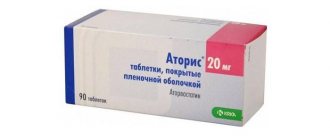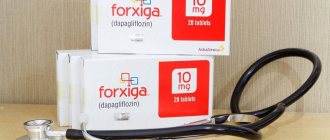Drugs of the pharmacological group statins are used to treat high cholesterol index in especially severe cases, when changes in the usual lifestyle and an anti-cholesterol diet have not been able to bring the concentration of cholesterol molecules to normal levels.
Such lipid-lowering drugs include the drug Simgal. The active component of this medication is simvastatin, which has the properties of lowering the concentration of cholesterol molecules in the blood over a short therapeutic course.
Compound
| Film-coated tablets | in one tablet |
| current active ingredient: | |
| simvastatin | 10.0 milligrams |
| 20.0 milligrams | |
| 40.0 milligrams | |
| auxiliary components in the tablet: | |
| ascorbic acid | 2.50 milligrams |
| butylated hydroxyanisole molecules | 0.020 milligrams |
| gelatinized starch | 10.0 milligrams |
| citric acid monohydrate | 1,250 milligrams |
| magnesium stearate molecules | 1.70 milligrams |
| MCC | 5.0 milligrams |
| lactose | up to 100.0 milligrams |
The shade of the shell of the tableted medication Simgal differs depending on the dosage of the active component simvastatin:
- A medicine with a dosage of simvastatin 10.0 milligrams is a light pink shade;
- Tablets containing 20.0 milligrams of active ingredient are pink in color;
- A medication with an active ingredient of 40.0 milligrams is a dark pink shade.
Packaging form of the drug Simgal:
- The tablets are packaged in blisters. Their number in one blister is 14 pieces;
- Blisters are packed in a cardboard box of 2 or 6 blisters;
- Simgal tablets are packaged in a bottle of 28 pieces;
- Each bottle is packed in a cardboard box.
The manufacturer includes instructions for use in each box along with the tablets.
Instructions for use
Simgal
Active substance:
Simvastatin*
Pharmgroup:
Statins
Analogs for the active substance:Actalipid Aterostat Basilip Vero-Simvastatin Zokor Zokor forte Zorstat Owencore SymvaHEXAL Simvacard Simvakol SYMBALIMIT Simvastatin Simvastatin Alkaloid Simvastatin Pfizer Simvastatin-Chaikapharma Simvastol symbol Simlo Syncard Kholvasim | Application area:Heterozygous hereditary hypercholesterolemia Heterozygous nonfamilial hypercholesterolemia Heterozygous familial hypercholesterolemia Hypercholesterolemia Primary hypercholesterolemia Homozygous familial hypercholesterolemia Homozygous sitosterolemia Isolated endogenous hypercholesterolemia Coronary heart disease due to hypercholesterolemia Chronic ischemic heart disease Myocardial ischemia in arteriosclerosis Recurrent myocardial ischemia Combined hyperlipidemia Combined hypercholesterolemia and hypertriglyceridemia Combined hypercholesterolemia and triglyceridemia Coronary heart disease Primary hypercholesterolemia Elevated cholesterol levels Increased blood cholesterol levels Familial hypercholesterolemia Mixed familial hypercholesterolemia Stable ischemic heart disease Phytosterolemia Percutaneous transluminal angioplasty Endogenous hypercholesterolemia |
Pharmacokinetics
Simvastatin is absorbed quite well, regardless of whether the drug is taken alone or with food. The maximum concentration in the blood is after 60 minutes -120 minutes.
In case of cirrhosis of liver cells, which is caused by alcohol intake, the concentration is 16-18 times higher than normal.
If you take Simgal tablets before bedtime, then the plasma concentration of the drug component atorvastatin is lower than its concentration in the morning.
Conversion into the active form occurs in liver cells, and no more than 5.0% of the total dose of the drug enters the bloodstream. The drug does not accumulate in the bloodstream and in liver cells.
Binding of the drug Simgal to plasma proteins is 95.0%.
Exit from the body of the drug Simgal is carried out through the intestines (60.0%) and through urine (13.0%).
The transit time through the body from the moment of ingestion to the moment of release is about 96 hours.
Simgal
Compatibility and mutual influence
The simultaneous use of Simgal and cytostatics, fibrates, and immunosuppressants can cause myopathy. Similar consequences are possible when combining the described remedy and medications:
- for the treatment of fungal infection;
- containing erythro-, clarithro-, telithromycin;
- inhibiting HIV protease;
- based on nefazodone.
The likelihood of myopathy increases when combining Simgal and other compounds that lower the concentration of lipids in the circulatory system. This also applies to the simultaneous use of simvastatin, verapamil, amiodarone, especially in a situation where Simgal is prescribed in a high dosage.
Simgal therapy requires monitoring of blood clotting quality indicators if the drug is used simultaneously with indirect coagulants, since the likelihood of bleeding increases. Coagulation tests should be done before starting a course of simvastatin, then repeated during treatment. The doctor will prescribe the frequency.
The use of formulations containing digoxin and simvastatin leads to an increase in the concentration of the former in the circulatory system. Under the influence of colestipol and cholestyramine, the bioavailability of simvastatin decreases. To prevent this, time intervals between the use of drugs should be observed: four hours or more.
Pharmacodynamics
The active component of the drug is simvastatin, which is an inhibitor of HMG-CoA reductase molecules. Reductase is responsible for the synthesis of mevalonic acid, which is part of sterols and the cholesterol molecule.
The active component simvastatin lowers the concentration of cholesterol molecules in the blood, also by increasing the number of LDL receptors, which enhance the catabolism of low molecular weight cholesterol, reducing it.
This drug is prescribed only when the concentration of cholesterol molecules is high enough, because if it increases slightly, the drug is not prescribed due to its wide side effects on the human body.
With an increase in the concentration of total cholesterol in plasma blood, as well as its low molecular weight fraction, there is a danger of developing the systemic pathology atherosclerosis.
An increase in the fraction of low molecular weight lipoproteins increases the risk of developing pathologies of the heart organ and blood flow system.
In addition to reducing the concentration of low molecular weight lipids, Simgal catalyzes the synthesis of high molecular density lipoproteins, which have the ability to collect free cholesterol molecules and transport them to liver cells for further utilization.
An increase in high molecular weight lipoproteins reduces the risk of heart pathologies, and also prevents the bloodstream from the formation of atherosclerotic plaques.
A drug from the group of statins, Simgal, is quite well absorbed by the digestive tract. The release of statins from the body begins within an hour after taking the tablets with the help of bile and urine.
The active component simvastatin, which is not absorbed by the gastric mucosa, leaves the body within a period of up to 96 hours.
Quite often, Simgal is prescribed not only for high cholesterol index, but also for the risk of developing cardiac pathologies, as well as pathologies of the vascular system.
Simgal is prescribed not only for high cholesterol index
Indications for use
Simgal tablets are prescribed for the treatment of the following pathologies:
- Homozygous and heterozygous hereditary hypercholesterolemia;
- The primary pathology is hypercholesterolemia;
- Mixed pathology of dyslipidemia;
- Systemic pathology atherosclerosis.
Simgal is also prescribed for preventive purposes:
- In case of atherosclerosis pathology, to prevent the development of a complicated form;
- For diabetes mellitus to reduce the risk of developing systemic pathologies and diseases of the heart organ;
- For unstable angina, to prevent the development of myocardial infarction.
Reception scheme
Before taking a medication to lower cholesterol levels, you must carefully study the instructions for use and strictly follow all the requirements specified in the annotation for Simgal.
Using Simgal tablets as self-medication is prohibited, because only the attending doctor will be able to select the correct dosage and prescribe a treatment regimen.
Do not forget that treatment with various groups of statins must be carried out in combination with an anti-cholesterol diet.
The daily dose of the drug can be 10.0, 20.0, or 80.0 milligrams. The maximum dosage is prescribed in rare cases when the cholesterol index is over 8 - 9 mmol per liter. Therapy with the maximum dose is carried out under the supervision of a doctor and in a hospital setting.
It is not recommended to combine taking Simgal tablets with food.
If there is a need to divide the tablet into 2 parts, then this should be done with a knife, rather than breaking it manually.
For hypercholesterolemia, a daily dosage of 10.0 milligrams is prescribed. For ischemia of the cardiac organ, a dose of 20.0 milligrams is prescribed; for atherosclerosis, the dose of the drug is 20.0 - 40.0 milligrams per day.
If the patient has kidney cell pathologies, then to reduce the cholesterol index, the doctor prescribes a dose of 5.0 milligrams per day. The same dosage is prescribed when taken in complex therapy with fibrates.
The first drug effect can be felt after 14 days of taking Simgal.
Dose adjustments can be made only after taking the drug for a month, and during this period the drug can be replaced with an analogue or another statin.
Therapeutic course: who is recommended?
The drug "Simgal" is used for hypercholesterolemia. If the primary form of the disease is diagnosed, according to Fredrickson’s typology, belonging to the Pa or Pb groups, “Simgal” is indicated as an adjunct that complements treatment with diet and other non-drug approaches to normalize the patient’s condition. At the same time, it is recommended to intensify physical activity and engage in procedures to normalize weight. "Simgal" is prescribed only when non-drug measures do not show the desired effect.
It is recommended to use the drug in the treatment of persons who have:
- combined form of hypercholesterolemia;
- hyperlipoproteinemia;
- hypertriglyceridemia.
For all these diagnoses, treatment begins with diet and lifestyle changes, and medication is taken if such measures do not show results.
Inherited hypercholesterolemia (in homozygous form) also allows the use of Simgal, but only as an additional stage of the therapeutic course. The main treatment is diet, LDL apheresis and other techniques that help normalize the fat profile of the blood.
Overdose
If an overdose occurs during Simgal therapy, then it is urgently necessary to take measures to restore all body functions that were affected by the increased dosage of the drug:
- It is necessary to use gastric lavage and remove any remaining medication taken;
- Take sorbents that will help remove toxic substances from the body;
- If necessary, I use laxatives.
Symptomatic treatment is also carried out. In case of overdose, the hemodialysis method does not give a positive result.
Too much!
There is no official information about the presence of specific symptoms of an overdose of Simgal. From practice, there is evidence of ingestion of up to 450 mg of the active substance, but no special manifestations were observed. If an overdose occurs, you should initiate vomiting, drink sorbents and carry out therapy to normalize the condition, taking into account the symptoms that are troubling in a particular case. For some time after the incident, you need to monitor the functioning of your kidneys and liver, and take a blood test for CPK activity. If an overdose provokes myopathy or acute renal failure, stop using Simgal and use a diuretic, sodium bicarbonate in the form of a solution for injection into a vein. In some cases, hemodialysis is prescribed.
Against the background of rhabdomyolysis, accumulation of excess amounts of potassium in the blood is possible. To correct the patient's condition, calcium chloride or gluconate is administered, a dextrose solution and short-acting insulin are infused. In the most severe cases, hemodialysis is indicated.
Interaction with other drugs
The pharmacological properties of the drug Simgal do not always interact with the medicinal properties of other drugs, therefore, when prescribing the statin Simgal, it is necessary to take into account what drugs the patient is currently taking, as well as what drugs can be combined to enhance the drug effect.
Otherwise, this may affect the patient’s health and the metabolism of simvastatin in the body:
- Medication Cyclosporine . When used together, the concentration of the drug simvastatin in the blood increases several times. Therefore, the combined use of these two drugs is contraindicated;
- The drug Erythromycin and the antibiotic Tetracycline . When combined with a statin and an antibiotic, the concentration of simvastatin increased 8-fold. Therefore, it is either necessary to complete the course of an antibacterial drug and begin treatment with statins, or reduce the minimum dosage by half;
- When combined with Dinazole , as well as the drug Gemfibrozil, the risk of developing myopathy increases;
- The drug Niacin and Verapamil , there is a danger of developing the pathology of myopathy, as well as the pathology of rhabdomyolysis, therefore the use of these two drugs for joint treatment is contraindicated;
- The drug Rifampicin . With the simultaneous use of these two medications, the concentration of simvastatin increased several times. This was due to a decrease in its absorption by liver cells;
- When Simgal is used together with Bosentan, simvastatin decreases by 30.0%;
- The simultaneous use of statins with Fluconazole and Clarithromycin poses a risk of developing pathologies in the liver organ.
Simgal's analogs
Feedback about use
Among those patients who have taken Simgal for a long time, reviews about it are predominantly positive. In most cases, this is due to the drug being well tolerated and highly effective. When taking the drug systematically, patients with coronary artery disease and other cardiac pathologies note an improvement in their general condition, a weakening or complete disappearance of symptoms. There were no side effects observed in people who left reviews.
Reviews from medical representatives about the medicine are only positive. Doctors note positive dynamics in the patients’ condition, as well as an improvement in lipid profiles and their stabilization at a normal level. But nevertheless, one should not expect a lightning-fast effect - it develops gradually, but is highly persistent. Patients should remember that taking any medications, in particular Simgal, can be started only after a preliminary examination and consultation with a doctor and study of the instructions!
Contraindications
For the treatment of high cholesterol index, the drug is not prescribed in the following cases:
- Women during pregnancy and when feeding a baby with breast milk;
- With hereditary pathology porphyria;
- At the time the patient takes medications for HIV treatment;
- If the body is hypersensitive to simvastatin, as well as to other components in the tablets;
- Children's age up to 18 years of age.
With caution, it is necessary to prescribe the drug Simgal to women of reproductive age.
When taking the drug, good contraception is required to avoid unwanted pregnancy.
Women during pregnancy are prohibited from taking the drug
Side effects
The medication has many side effects that occur at different intervals in patients.
One patient out of 100 experiences the following negative effects:
- Insomnia, as well as memory impairment;
- Depressive state;
- Problems of a sexual nature.
One patient out of 1000 may experience the following side effects of the drug:
- Blood pathology - anemia;
- Pain in the head with varying intensity;
- Pathology paresthesia;
- Severe dizziness in the head;
- Muscle spasms;
- Disease polyneuropathy of peripheral organs;
- Disorders in the digestive tract that cause stomach pain and vomiting;
- Inflammatory process in the pancreas - pancreatitis;
- Various types of hepatitis;
- Allergic rashes on the skin and severe itching of the rash;
- Pathology alopecia;
- The disease is myopathy and myositis;
- Muscle spasms;
- Asthenia disease;
- Pathology angioedema;
- Systemic vasculitis;
- Arthritis;
- Polymyalgia of a rheumatic nature;
- Systemic pathology thrombocytopenia;
- Disease eosinophilia;
- Severe shortness of breath;
- Muscle weakness.
In extremely rare cases, liver and kidney organ failure may develop.
Recommendations for admission
When prescribing a medication, the doctor must warn the patient about all the features of statin therapy:
- If the patient experiences muscle pain or muscle weakness, immediately contact your doctor;
- If a planned operation is planned, it is necessary to stop taking Simgal a week before it;
- Before you start taking it, you need to examine your liver cells;
- Before starting a course of medication with Simgal, apply an anti-cholesterol diet;
- It is prohibited to consume grapefruit juice during therapy with Simgal tablets;
- During the medication course, do not drink alcoholic beverages.
Analogs
Many patients cannot afford to be treated for a long period with the drug Simgal, because its cost is higher than its analogues.
Analogues of the drug have the same therapeutic effect, but are much cheaper.
Analogues of Simgal:
- The drug Vasilip;
- Medicine Vero-Simvastatin;
- Medicine Simvastatin;
- Simvastol tablets;
- The drug Vastatin;
- Medicine Simvacard;
- Tablets Simvalimit;
- The drug Zocor;
- Vasostat tablets.
Akorta Atomax Lipitor Owencor Pravastatin Simvastol
Prices
| name of the drug | active ingredient dosage | number of pieces per package | price of the drug in Russian rubles |
| Simgal | 10 | 28 tablets | 217,00 — 224,00 |
| Simgal | 10 | 84 pieces | 591,00 — 611,00 |
| Simgal | 20 | 28 tablets | 282,00 — 392,00 |
| Simgal | 20 | 84 tablets | 593,00 — 880,00 |
| Simgal | 40 | 28 tablets | 584,00 — 650,00 |
| Simgal | 40 | 84 tablets | 1357 |
Special conditions and dosage
Analogs based on simvastatin “Simgal” (20 mg and a different dosage of the active compound) can be used to treat older people, provided that vital signs of the body’s functioning are monitored. In this case, the drug is used in the dose recommended for diagnosis; no specific reduction or increase in volume is required.
If mild or moderate renal failure is established, the dosage is also not adjusted. In severe cases, when creatine clearance is less than 30 ml/min, simvastatin should be used per day in an amount of no more than 10 mg. Therapy requires regular check-ups with a doctor.





